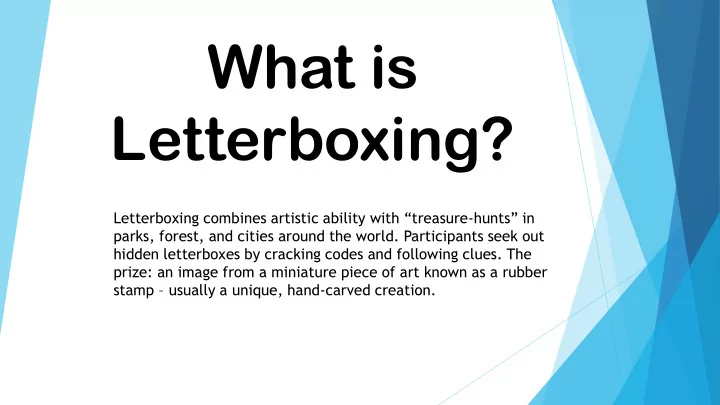

What is Letterboxing? Letterboxing combines artistic ability with “treasure - hunts” in parks, forest, and cities around the world. Participants seek out hidden letterboxes by cracking codes and following clues. The prize: an image from a miniature piece of art known as a rubber stamp – usually a unique, hand-carved creation.
Why Letterboxing? World wide activity; anywhere you go Get to know an area or city in a fun and exciting way through hikes or a drive by Create a logbook of artfully carved stamps A log of your tips and experiences Fun times with family and loved ones Craft and create new rubberstamps
Letterboxing history 1854: Dartmoor England – James Parrott 1888: Tin Box with self-addressed postcard 1905: Logbook added to record attendance 1907: Rubber stamp added to prove Dartmoor location 80 years to plant 2 more boxes 1998: Smithsonian magazine published article about Letterboxing 2001: LBNA recognized over 1000 in 50 states 2004: Atlas Quest – online logbook of finds and plants
AtlasQuest.com home page
How do you get started? Atlasquest.com is a great (free) site to use for Letterbox searches
Search results… <1mile 1-2 miles 2-4 miles 4-8 miles 8-15 miles Key: Hand=carved stamp, Car=drive by, the box is close to your car, Shoes=hike and distance, Dog=dog friendly, Bike=bike friendly, Money bag=entrance fee, Blue Diamond=AQ highly recommended, Plant=plants are part of the clue or the journey, Building=indoors
Click on the box name
Record your find on-line
Finding the box… On a hike
Finding the box… Normally a plastic box or a pouch
Finding the box… At the beach…
Finding the box In a tree
Finding the box… Under a rock
What you’ll need to start Logbook (store bought or homemade is fine) Personal stamp Ink pad/pens
Stamp the box logbook with your personal stamp
And stamp your personal logbook with the box stamp
Letterboxing code of conduct Code of conduct Leave no trace – Leave the area as you found it. Be respectful of vegetation. Safety: Part 1 – Be respectful of wildlife. Bears, snakes, and venomous creatures should be left alone. Never leave any of your personal information in a box. Use only your trail name. Safety: Part 2 – Pack a bag with daypack supplies (water, bandages, flashlight, matchers, granola bars, cell phone, insect repellant, etc.) Security – Since the September 11 th disaster the community is more aware of suspicious activity or boxes left behind. Pay attention to security and keep yourself safe. Respect – Long list available at atlastquest.com Pets – Only take your dog is approved areas. Clean up after your dog and make sure your dog has good doggie manners (no jumping, no chasing, sit/stay on command, etc.)
How far does it reach? 130 countries Afghanistan to Zimbabwe US #1 - 93,250 54 states and territories Massachusetts #1 -7,750 13 Canadian provinces Ontario #1 – 1,170
Recommend
More recommend